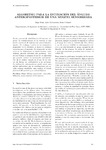Algoritmo para la estimación del ángulo anteroposterior de una muleta sensorizada

Use this link to cite
http://hdl.handle.net/2183/23670
Except where otherwise noted, this item's license is described as Atribución-NoComercial-CompartirIgual 4.0
Collections
Metadata
Show full item recordTitle
Algoritmo para la estimación del ángulo anteroposterior de una muleta sensorizadaAlternative Title(s)
Estimation of the anteroposterior angle of a sensorizes crutchDate
2019Citation
Sesar-Gil, I., Zubizarreta, A., Cabanes, I. (2019). Algoritmo para la estimación del ángulo anteroposterior de una muleta sensorizada. En XL Jornadas de Automática: libro de actas, Ferrol, 4-6 de septiembre de 2019 (pp. 101-106). DOI capítulo: https://doi.org/10.17979/spudc.9788497497169.101. DOI libro: https://doi.org/10.17979/spudc.9788497497169
Abstract
[Resumen] En los procesos de rehabilitación del miembro inferior, la monitorización de la marcha es una fuente sustancial de información para el fisioterapeuta. Sin embargo, muchos de los dispositivos propuestos en la literatura se basan en sistemas invasivos para el paciente. La integración de sensores en los dispositivos de ayuda técnica, como muletas, permite solventar este problema. Así, en este trabajo se propone el uso de un algoritmo que permite estimar la inclinación anteroposterior de la muleta, basado en el uso de un sensor de fuerza, un inclinómetro y un giróscopo. La inclinación anteroposterior puede servir para definir indicadores que se correlacionen con escalas clínicas empleadas para evaluar el estado funcional del paciente y su actividad física. [Abstract] In lower limb rehabilitation therapies, gait monitoring is an interesting source of information for the therapist, as it allows to personalise the therapy to the particular needs of each patient. However, most devices proposed in the literature are based on invasive solutions that hamper the motion of the patient. Integrating sensors in assistive devices such as crutches allow to solve this issue. This way, in this work a novel algorithm is proposed, which allows to estimate the anteroposterior motion of the crutch, using a force sensor, an inclinometer and a gyroscope. This estimation can be used to define indicators that can be used to evaluate patient status, being an important source of information for the therapist.
Keywords
Muleta sensorizada
Neurorehabilitación
Monitorización de la marcha
Sensorized crutch
Neurorehabilitation
Gait monitoring
Neurorehabilitación
Monitorización de la marcha
Sensorized crutch
Neurorehabilitation
Gait monitoring
Editor version
Rights
Atribución-NoComercial-CompartirIgual 4.0
ISBN
978-84-9749-716-9






